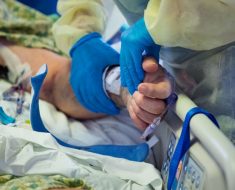Child abuse could leave ‘molecular scars’ on its victims: Study identifies ‘trauma footprint’ in the genes of survivors – and it could be screened for in criminal investigations
- Millions of children are the victims of reported abuse every year in the US
- Far more likely go unreported, and perpetrators are not caught
- Recent research reveals that trauma has mental effects, not just physical ones
- New Harvard University and University of British Columbia research reveals that victims of child abuse have damage to their epigenetics
- These changes affect sperm, so the damage may be passed down to their kids
- The researchers say their discovery may someday help investigators confirm that claims of past traumas – like child and sexual abuse – are true
Child abuse doesn’t just leave physical and emotional scars, but molecular ones that may even be passed to future generations through genetic changes, a new study reveals.
Child Protective Agencies receive reports that more than 6.6 million American children are being abused or in danger of abuse every year – and that doesn’t include an unknowable number who suffer in the dark.
Genetic markers of trauma discovered by researchers at Harvard University and the University of British Columbia could help someday help catch child and sexual abusers – even decades after their crimes were perpetrated.
Psychologists have long urged that the damage done in childhood stays with us throughout our lifetimes and the new study shows that these toxic environments our biology – right down to the genes we pass along to their own kids.

Victims of child abuse have epigenetic markers that may someday help criminal investigators verify their claims and catch their perpetrators, the authors of a new study suggests
Every 10 seconds, child abuse is reported in the US, according to the non-profit Childhelp.
Children that survive this sort of trauma at home as they grow up can look forward to an adult life free of their abusers – but not, science shows us, free of the lasting effects of abuse.
There is the obvious mental and behavioral fallout: falling into an abusive domestic partnership, depression, PTSD and elevated suicide risks. About 80 percent of young adults who endured abuse have at least one diagnosable mental disorder.
But the impact of abuse on physical health, even decades later, is less obviously traced to abuse, but every bit as debilitating for these survivors, and possibly even to their children, as the new Harvard and UCB study suggests.
Due in part to higher levels of the stress hormone, cortisol, they face elevated risks of heart and liver disease as well as COPD, a breathing disorder closely-linked to smoking, which abuse victims are more likely to take up at younger ages.
Overall, childhood abuse survivors face a harder, shorter life, with some studies estimating their life expectancy is cut by an average of two decades.
Only in the last several years have scientists really begun to unearth the deeper destruction done to abuse victims, discovering that trauma penetrates to a cellular and even molecular level.
-

America’s history of racism in medicine: From Tuskegee to…
Online sperm donors are ‘harassing women and pressuring them…
Share this article
Often, victims of sexual assault and childhood abuse alike are scared into remaining silent for years, even decades. Even when they do eventually come forward, investigations and trials become matters of he-said she-said.
But identifying biological markers of abuse could change that.
The latest study examined how it affects methylation, one of the hottest topics in science of late.
Methylation is a process of chemical tagging that helps regulate gene expression, which in turn tells various processes when to switch on and off.
‘It’s the reason that even though you have the same DNA in every cell in your body, your eye cells are really different from your heart cells and your skin cells and so on,’ explains lead study author Dr Andrea Roberts.
Dr Roberts, a Harvard University professor who studies the effects of trauma across a life and across generations, says that methylation plays a key role in what each cell does with those genes.
‘Genes are like the pantry and each cell has its own recipe, and the way that’s implemented is in part due to methylation,’ she says.
Methylation is part of the wider umbrella of epigenetics, or how genes are changed and expressed and, sometimes, passed down.
‘We know that [epigenetics] are how your experiences get under your skin,’ says Dr Roberts.
When methylation isn’t happening properly, the whole mechanism of gene expression gets glitchy.
‘The best analogy is a dimmer switch: if the gene is the light, is that light on or off, and is it super bright or barely burning,’ says Dr Roberts.
This can be damaging to all manner of processes, including – and perhaps especially – reproductive ones.
Dr Roberts, her team at Harvard and their collaborators the University of British Columbia compared chemical tags or methylation in the DNA of 34 adult men’s sperm.
They had already identified a subset of abuse victims in the group, and when they examined the DNA of each, they saw distinct differences in the DNA of the abuse survivors compared to that of those who had no history of abuse.
Differences were clear on 12 different DNA regions, and while there was only a 10 percent ‘dimming’ effect on some, other regions differed by as much as 29 percent between non-victims and victims.
Previous research had already shown that epigenetics – the effects of pollution for example – play a crucial role in the concentration and health of sperm.
Those that are poorly formed, son’t swim well, swim in circles, and ‘have a hard time getting the job done,’ says Dr Roberts.
Not only did she and her collaborators find that the sperm showed poorer methylation, but the men who had gone through child abuse had lower concentrations of sperm, too.
That ‘adds to the evidence that child abuse has serious affects on our bodies in many ways, and opens the possibility that it might have an effect on the offspring through the father – something people have not given much though to before now,’ says Dr Roberts.
‘Our life experience has marks on our bodies in a lot of different ways.’
Already, scientists can use tissue samples – like a bit of skin – to estimate age using epigenetics – something that DNA doesn’t show on its own.
‘I don’t think it’s crazy to think that … in a decade, with a lot more information, that these epigenetic signatures might be some kind of signal for trauma,’ says Dr Roberts.
We are a long way off from using epigenetic signals to distinguish what kind of trauma someone has gone through, and when, Dr Roberts says we might someday get there.
And childhood experiences and environments tend to leave especially lasting biological marks, Dr Roberts says.
‘Trauma affects our biology. Whether at some point we are able to pull out all those indicators and make some kind of picture remains to be seen,’ she says.
Source: Read Full Article





